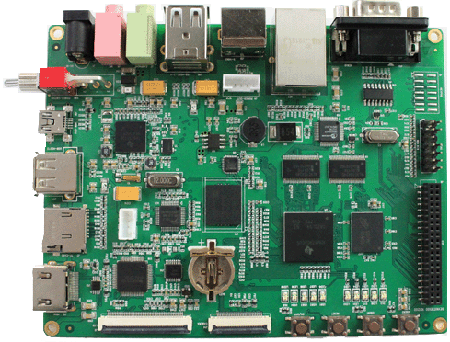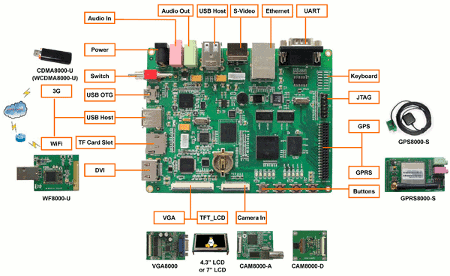Cortex-A8 dev board takes on the BeagleBoard-xM
Nov 17, 2011 — by Eric Brown — from the LinuxDevices Archive — 25 viewsEmbest is shipping a single board computer based on the Texas Instruments Cortex-A8-based DM3730 or AM3715 system on chips. The DevKit8500D — also available from Premier Farnell's Element14 engineering community as the DM3730-EVK Evaluation Kit — is equipped with DVI-D, Ethernet, USB 2.0, and serial expansion interfaces, plus options including touchscreens, wireless modules, and cameras.
Texas Instruments (TI) announced the DaVinci DM3730 system on chip (SoC) in Aug. 2010, two months after unveiling the similar Sitara AM3715. The DM3730 is essentially identical to the AM3715, except for the addition of a video accelerator that enables 720p video playback and recording. Both SoCs include an 800MHz C64x+ DSP digital signal processor) core and a 3D graphics accelerator, and can be clocked up to 1GHz.

Embest DevKit8500D
China-based Embest — a long-time partner of ARM — has begun shipping both a DevKit8500D single board computer (SBC) based on the DM3730 and a DevKit8500A board based on the AM3715. The SBCs otherwise appear to be identical. Meanwhile, Premier Farnell's Element14 engineering community has begun selling an almost-identical DM3730-EVK Evaluation Kit, and it offers the AM3715 as an option.
Speaking of options, these boards are loaded with them, appearing to provide developers a wider range of choices, not to mention more built-in ports, than BeagleBoard.org's DM3730-based BeagleBoard-xM. The pricing is not that much higher, either, and Embest appears to share the same zeal for releasing open schematics. (Other DM3730-based SBCs include InHand Electronics' Apeiron Fury and TI's own more expensive evaluation module.)

DevKit8500D detail
(Click to enlarge)
Here we'll focus on the original Embest board, but features and options are almost identical on the Element14 offering (see links to both sets of data sheets at the end of the story.)
The 5.36 x 4.15-inch Embest DevKit8500D board supports up to 512MB of DDR SDRAM and 512MB of NAND flash storage, says the company. It is also said to offer a "reserved" (resumably meaning optional) 2GB iNAND allotment that can be optionally soldered.
The board can boot Linux 2.6.32 or Windows CE 6.0 from either NAND flash or the built-in microSD slot. In its default configuration, it comes with Linux in NAND flash and Windows CE on a microSD card. The SBC also ships with an Android 2.2 demo with driver source code, including instructions on how to boot an Android demo image, says Embest.

Secondary DevKit8500D detail page, showing options
(Click to enlarge)
The DevKit8500D ships with a DVI-D port, an LCD touchscreen interface, and an S-video interface, says Embest. Display options include 4.3-inch or seven-inch LCD touchscreens, as well as a VGA module, says the company. A camera interface is supplied as well, and can be activated with optional digital and analog camera modules (see spec list below for details).
The board ships with a 10/100 Ethernet port, as well as four USB 2.0 host ports and a microUSB On-The-Go, says Embest. A serial debug port and audio I/O are also said to be available. The rest of the I/O is expressed via an expansion connector, offering serial interfaces including McSPI, McBSP, and I2C.
Wireless options include Wi-Fi, GPRS, 3G, and GPS modules, and a "XDS100v2" USB JTAG Emulator is also available as an option, says Embest. The board is said to be available in a kit with a user manual, schematic drawing, and other documentation, says the company.
Features and specifications listed for the DevKit8500D include:
- Processor - TI DaVinci DM3730 or TI Sitara AM3715 — each at 300MHz, 600MHz, 800MHz, or 1GHz — with integrated 800MHz C64x+ DSP and 3D engine
- Memory — 512MB DDR SDRAM; 512MB NAND flash; "reserved" 2GB 4-bit iNAND with optional soldering
- Expansion — microSD slot
- Display/camera:
- DVI-D port with HDMI to DVI-D cable
- LCD touchscreen interface (50-pin FPC connector, up to 2048 x 2048 pixels)
- S-video display interface
- optional VGA module (via LCD)
- camera interface with optional analog, digital, or digital/USB camera modules
- Networking — 10/100 Ethernet with RJ-45 connector
- Other I/O:
- 4 x USB 2.0 host ports
- microUSB OTG port
- RS-232 5-line debug port
- 3.5mm audio input and output jacks
- JTAG
- interfaces for 6×6 keyboard and 4 x buttons
- expansion connector (40-pin SMT):
- 2 x serial 5-line
- McSPI
- McBSP
- I2C
- H2Q
- optional UART extension module
- Wireless modules (all optional:
- Wi-Fi
- GPRS
- 3G (CDMA2000)
- GPS
- Power — +5V
- Operating temperature — 32 to 158 deg. F (0 to 70 deg. C)
- Dimensions — 5.36 x 4.15 inches (136.2 x 105.3mm)
Availability
The Embest DevKit8500D and DevKit8500A, as well as Element14's DM3730-EVK Evaluation Kit are available now. DevKit8500D pricing starts at $149 (minimum 10 units), moving up to $199 with data card, cables and power adapter, and either $309 or $329 when you add the 4.3-inch or seven-inch touchscreens, respectively.
The pricing for additional options, ranging from $25 to $79, may be found at Embest's DevKit8500D product page where many more hardware and software details are available. More information and pricing options on the similar DM3730-EVK Evaluation Kit may be found at Element14's DM3730-EVK Evaluation Kit page.
This article was originally published on LinuxDevices.com and has been donated to the open source community by QuinStreet Inc. Please visit LinuxToday.com for up-to-date news and articles about Linux and open source.